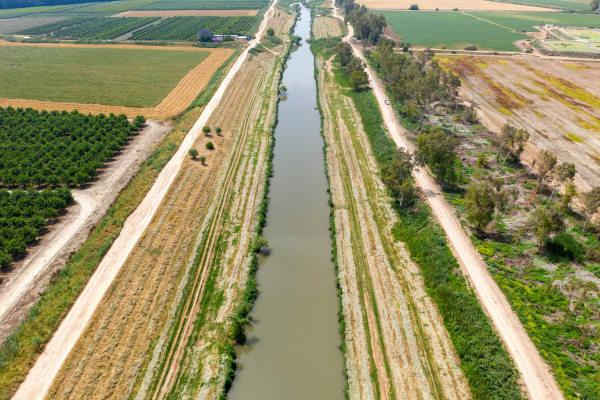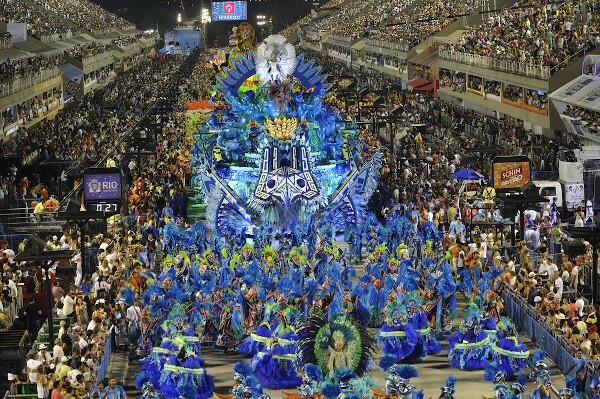O Jordan river is a watercourse located in the Middle East that borders Israel, the West Bank and Jordan. This river originates on Mount Hermon, between Syria and Lebanon, and follows a meandering path through very low-altitude terrain until it flows into the Dead Sea, 200 km from its source.
The Jordan carries enormous religious symbolism for Christians as well as Jews and Muslims. Despite its religious and economic importance, the waters of the Jordan River have lost volume and quality due to pollution and intensive use.
Read too: Nile River — another river of great historical, economic and cultural importance
Topics in this article
- 1 - Summary about the Jordan River
- 2 - General data on the Jordan River
- 3 - Where is the Jordan River located?
- 4 - Characteristics of the Jordan River
- 5 - Meaning of the Jordan River in the Bible
- 6 - What is the importance of the Jordan River?
- 7 - Degradation of the Jordan River
- 8 - Curiosities about the Jordan River
Summary about the Jordan River
The Jordan River is a watercourse located on the Asian continent, in the Middle East region, and which bathes the territories of Israel, Syria, the West Bank and Jordan.
It runs approximately 200 km from its source, on Mount Hermon, to its mouth, at the Dead Sea. It therefore moves in a north-south direction.
The course of the Jordan River bathes the lowest altitudes on planet Earth.
The greatest width of the Jordan River is 24 km, while its depth varies from 15 to 60 meters.
It is a perennial river, although it crosses areas with a hot and dry climate.
The Jordan River has great religious significance for Christians, Muslims and Jews.
According to the Holy Bible, which is the holy book of Christians, Jesus Christ was baptized in the waters of the Jordan River.
The Jordan River is important for the economy of the countries it borders, especially due to religious and leisure tourism. It also provides the development of irrigated agriculture.
The waters of the Jordan are used to supply cities and towns.
The intensive use of its waters, however, combined with water pollution, is the cause of the degradation of the Jordan River, as well as the reduction in its flow.
Do not stop now... There's more after the advertising ;)
General data on the Jordan River
Length: 200 km.
Source: Mount Hermon.
Source altitude: 2,814 meters.
-
Main tributaries of the Jordan River:
Right bank: Hasbani (or Snir) river, Yabis river, Harod river and Nahal Ayun stream.
Left margin: river Banias, river Yarmouq, river Zarqa and river Dan.
Mouth of the Jordan River: Dead Sea.
Where the Jordan River flows: Dead Sea, in the Jordan Rift Valley.
Average flow: 16 m³/s.
Basin area: 18,000 km².
Where is the Jordan River located?
The Jordan River is a watercourse located on the Asian continent, more precisely in the Middle East. This river serves as a natural border between the territories of Israel and Syria, also separating Israel and the West Bank (part of Palestine) from Jordan. Furthermore, its source is located on the border between Lebanon and Syria.
See the location of the Jordan River on the map below:

Characteristics of the Jordan River
The river Jordan is a watercourse that rises approximately 2,800 meters above sea level on Mount Hermon, mountain belonging to the Anti-Lebanon Mountains, which lies on the border between Lebanon and Syria. The waters of the Jordan are augmented by the waters of its main tributaries, such as the Hasbani, Banias and Dan rivers, right at the beginning of its route.
In its initial stretch, the Jordan River flows quickly until it reaches the Hula Valley, in Israel, which ends at the Sea of Galilee, also called Lake Tiberias. This stretch is 100 kilometers long, disregarding the meanders (curves). This first section of the Jordan River, which runs from its source until just before its arrival at the Sea of Galilee, It is known as the Upper Course of the Jordan River.

Until then, the Jordan River bathes areas that are located at positive altitudes, that is, above sea level. From its entry into the Sea of Galilee until its exit, in the area where the Degania dam was built, the Jordan River runs through an area of geographic depression where altitudes are around -210 meters, which means they are below sea level. From then on, the Jordan River receives a new influx of water from its tributaries and continues to the Dead Sea, where it flows through a delta mouth.
All This stretch, which runs from the Sea of Galilee to the Dead Sea, is called the Lower Course of the Jordan River, and runs through a region called the Jordan Valley, which is part of a geomorphological unit known as the Jordan Rift. Before the meandering course, the Jordan River then acquires a less irregular path in the second part of its path.
It is in its lower course that the river acquires its greatest extent between one bank and another, reaching 24 kilometers. The region where the Jordan River reaches its greatest width is known as the Plain of Ghor (or Ghawr), being formed by flat and gently undulating terrain devoid of vegetation due to the climate arid. Annual rainfall in this area amounts to just 75 mm, while the Hula Valley, to the north, records 500 mm of precipitation per year, helping to ensure the perpetuity of the Jordan River.

The depths of this watercourse range from 15 meters at its shallowest point to 60 meters at its deepest point. Furthermore, as we mentioned, the Jordan River crosses some of the lowest altitude areas on planet Earth. In the Jordan Valley, the river's discharge point is the Dead Sea, where its lowest point is, at -400 meters below sea level.
See too: What are the parts of a river?
Meaning of the Jordan River in the Bible
The Jordan River is full of meaning for Christians of all persuasions, being mentioned in numerous passages in the Bible. According to this holy book, It was in the waters of the Jordan River that Jesus Christ was baptizedby John the Baptist and soon after he had his encounter with the Holy Spirit. Also along the course of the Jordan River was where Christ performed many of his sermons.

The crossing of the Jordan River carried out by the Hebrews and led by Joshua, as mentioned in the Bible, marks the arrival of those people in the Promised Land after forty years of travel. It is noted that this path along the Jordan bed was made in an east-west direction and, during the crossing, the river that normally flowed through the place opened, thus allowing the passage of the entire Hebrew people.
In addition to these episodes, The Bible also narrates the rise of the prophet Elijah to the heavens when he was on the bank of the Jordan River, just like the healing power of its waters, who acted to cure Naaman of leprosy.
What is the importance of the Jordan River?
The religious symbolism of the Jordan River, not only for Christians, but also for Jews and for Muslims, gives this river great importance. Because of this, the religious tourism that is carried out forhas become a relevant economic activity to countries like Israel and Jordan. In many cases, it is common for religious groups to make a pilgrimage to the Jordan River to be baptized in its waters, as happened with Jesus Christ, and to perform other religious rituals.
In addition to the religious aspect, there are other factors that make the Jordan River fundamental for the region and the countries it bathes. Syria, Lebanon and Israel obtain a large part of their water supply from the waters of the Jordan River.

This watercourse is also responsible for irrigation, which allowed the development of agricultural crops in an area with a very hot and dry climate. Among the products that are grown with the help of the waters of the Jordan River are vegetables, oranges, bananas and beets. Leisure tourism and sports are also carried out on the Jordan River.
Know more: Jerusalem — another site considered sacred to Christians, Muslims and Jews
Degradation of the Jordan River
The degradation of the Jordan River is an environmental problem that worries authorities and individuals who depend on its waters for subsistence, whether for the development of agriculture, whether for direct consumption or indirect. The main threats to the water quality of the Jordan River are:
intensive use resulting from the need to obtain water resources in different locations, which almost includes all the countries through which this river passes, and tourist activity for both leisure and religious;
Pwater pollution resulting from both tourism and the irregular disposal of waste or inadequate management of agricultural areas, which end up sending substances to nearby water sources.
It is estimated that both The factors mentioned above are responsible for thediversion of 95% of the course of the Jordan River, which is why its annual discharge into the Dead Sea has decreased considerably from the 1960s to the present.
Curiosities about the Jordan River
The length of the Jordan River is, in reality, 360 km. However, due to its meanders, its north-south length, from source to mouth, is 200 km.
Due to the altitude of the areas it crosses, the Jordan River is classified as the lowest river in the world.
The Jordan River sends between 20 and 30 million cubic meters of water to the Dead Sea every year.
The area where the Jordan River flows into the Dead Sea is approximately 400 meters below sea level.
Canals built and fed with the waters of the Jordan River allowed the settlement of many areas that were uninhabited due to climatic and soil conditions, such as the Al-Grawr region between the 1960s and 1970s.
Image credits
[1] kavram/ Shutterstock
Sources
GHOSH, DIPTARKA. Jordan River. World Atlas, 07 Oct. 2021. Available in: https://www.worldatlas.com/contributor/diptarka-ghosh.
ROBBIN, Zoe; PEARSON, Jack; PURVIS, Tiomothy. A Holy River at Risk. Think Global Health, 19 Dec. 2022. Available in: https://www.thinkglobalhealth.org/article/holy-river-risk.
THE EDITORS OF ENCYCLOPAEDIA BRITANNICA. Jordan River (river, Middle East). Encyclopaedia Britannica, [2023]. Available in: https://www.britannica.com/place/Jordan-River.
Would you like to reference this text in a school or academic work? Look:
GUITARRARA, Paloma. "Jordan river"; Brazil School. Available in: https://brasilescola.uol.com.br/geografia/rio-jordao.htm. Accessed on November 29, 2023.

